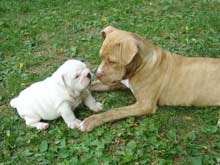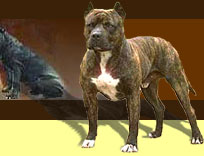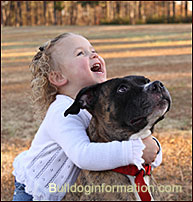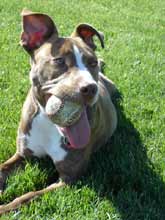American Pit Bull Terrier
(Pit Bull, Pit Bull Terrier, Pit bull Dog, American Pit Bull, American Pit Bull Dog)
© by C. Marien-de Luca for The Canine Information Library and The Bulldog Information Library 2003-2011.
The American Pit Bull Terrier is a thickly muscled dog with a well-defined neck and a bricklike head, known for its strength, loyalty, and "gameness," or tenacity. One of several breeds informally referred to as "pit bulls", it is also, in our opinion, erronuously classified in the terrier group by most kennel clubs.
History and Origin
Decades ago, the Pit Bull was known as a much loved, much trusted, worthy companion. Many considered it one of the safest of all breeds to be around children, and even in England (where it is now banned) it was referred to as the "nanny dog". Hollywood's "Little Rascals" movies illustrate this aspect of the breed as well. More about the American Pit Bull Terrier's history >>
Colby Logan
Photo courtesy Lou Colby
Today
Unfortunately, in recent years, the breed has received a lot of bad press and these dogs have become the victim of a real witchhunt. On the one hand, part of the media is responsible for escalating isolated incidents in its usual unrelenting and attention-getting way, and, on the other, there are those unscrupulous breeders who have produced dogs with highly aggressive tendencies. Some owners have also used these dogs to boost their macho image, exacerbating the dog's temperament either by ill-breeding or harsh training.
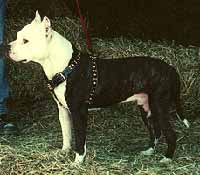
Even good, intentioned owners, sometimes unknowingly harm the breed, when convinced that a dog's temperament is ultimately influenced only by "how you raise them", they expect their American Pit Bull Terrier to live in conditions and behave in a way that is not compatible with the temperament of a true working breed. Even when they are being raised as pets, workings dogs like the American Pit Bull Terrier must be given some activity to do, like obedience training or any kind of dog sports or activities. In all cases they are best suited to active persons and families.
Temperament
Red nose American Pit Bull Terrier
Photo by Waldemar Dabrowski
Please note that it is not uncommon for an adult pit bull to be very quarrelsome towards other dogs while being very friendly to humans.
However, even though pit bulls were once bred to fight each other, breeders took great care in producing dogs that were trustworthy and friendly to people.
APBT Miesha with bulldog puppy
This doesn't mean that pit bulls can't be around other dogs or that they are unpredictably aggressive. It simply means that pit bulls can easily be encouraged to be aggressive towards other dogs or, in other words, it takes less to arouse a pit bull than it does for many other breeds to be aggressive towards other dogs.
Famous American Pit Bull Terrier Lines
Famous and/or historic blood lines are Old Family Red Nose (famous for their determination and agility), Caver (powerful), Colby (velocity and swiftness), Corvino, Hammonds, Klaus (Eddie), Clouse (Bert), Adams, Tudor and many others who show the coherence and success typical of the true Pit Bull breeders' philosophy. To avoid any of the potential problems described above, please buy your pit bull puppy from a reliable and responsible breeder !
Today, the American Pit Bull Terrier continues to demonstrate its versatility, competing successfully in Obedience, Tracking, Agility, Protection, and Weight Pulls, as well as Conformation.
That was a necessary trait in these dogs, because handlers had to be in the pits while their dogs were fighting, ready to pull them apart to end a fight. Any dog who redirected their aggression to a person was culled. Also, these "early" pit bulls usually lived in their owner's homes with the whole family. That's how the dogs actually earned the nickname of "nursemaid's dog" because they were so reliable with young children.
Moreover, inter-species aggression is common in many dog breeds like the Akita, Rottweiler, Doberman, terriers, Malamutes, Malinois, etc. and, as a consequence, is not something that should stop owners from enjoying many activities and sports with their dog. It just means that these dogs do require responsible owners who are willing to put the necessary time, money, thought and effort into managing their dog.
.
.
.
.
The
Canine Information Library and
Dogbreeds.bulldoginformation.com 2003-2011 © All rights reserved. Photos © Suemack (Pit Bull in Santa hat).
Original idea, design and development by C. Marien-de Luca. No part of bulldoginformation.com may be copied, distributed, printed or reproduced on another website without the owner's written permission. Please feel free to link from your site to any of the pages on this website in a non-frame presentation only.
An Owner's Guide to Raising
Your Pet Protector
by Lori Berg, Michael ''Gypsy'' Stratten
More information:
The American Pit Bull Terrier Handbook
(Barron's Pet Handbooks)
by Joe Stahlkuppe
The American Staffordshire Terrier :
Gamester and Guardian
(Howell's Best of Breed Library)
by Sarah Foster
Colby's Book of the American Pit Bull Terrier
(Hardcover)
by Louis B. Colby, Diane Jessup
More information:
The Ultimate American Pit Bull Terrier
(Howell Reference Books)
(Hardcover)
by Jacqueline O'Neil
Appearance
Pit Bulls are traditionally a working/performance breed, so coat color was about the least important thing that oldtime breeders cared about.
Today, Pit Bulls come in almost every color that is genetically possible. Brindle and fawn are the more common colors, while spotted or black-and-tan are not that often seen, but nevertheless accepted colors. Blue and red nosed dogs do occur, but are not to be considered a rare or separate type of Pit Bulls. The priority should always remain health and performance, indifferently of the nose color.
Recently, the APBT community has seen the emergence of the merle color pattern in their breed, probably due to outcrosses to Catahoula bulldogs, themselves crossbreeds from Catahoula leopard dogs and bulldogs or pit bulls. This color pattern is strongly opposed by many APBT enthusiasts. They claim the merle allele has never been present in the American Pit Bull Terrier gene pool for the last centuries and must therefore necessarily be the result of recent outcrosses.
APBT 'Porter' with Nathalie
Photo by Nina Shannon
If they plan or believe otherwise, they are just not being fair to the dog and to the community they live in. Of course, many pit bulls CAN and DO behave like golden retrievers, beagles and other breeds bred specifically for "pet-only" temperament traits, however, it is unfair to expect EVERY pit bull, or any other member of a true working dog breed, to do so, no matter what.







